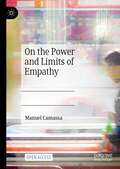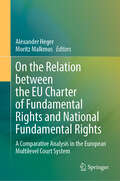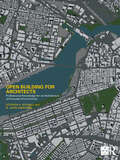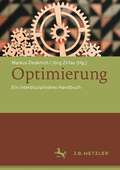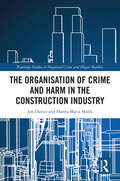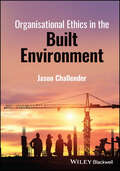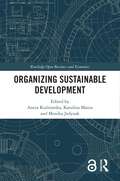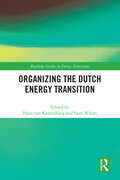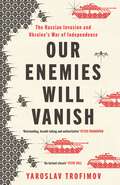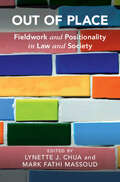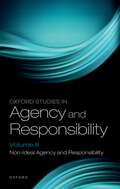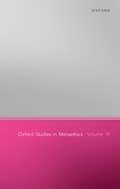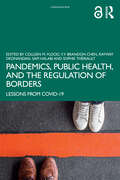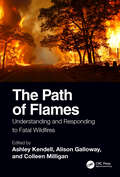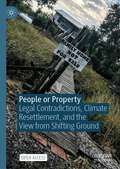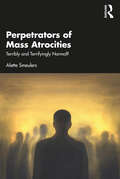- Table View
- List View
On the Power and Limits of Empathy
by Manuel CamassaThis book has two main objectives. The first is to identify and adequately describe the phenomenon of empathy. This essentially means offering a strong, reasoned and accurate description of the phenomenon of empathy in order to capture the essence of the empathic phenomenon and clearly distinguish it from other similar emotional phenomena such as sympathy or compassion The second part focuses on the role that this phenomenon can play on the ethical-moral level. The question is whether empathy is necessary or at least important for morality, and if so, to what extent, in what way and for what reasons. This is an open access book.
On the Relation between the EU Charter of Fundamental Rights and National Fundamental Rights: A Comparative Analysis in the European Multilevel Court System
by Alexander Heger Moritz MalkmusThe sometimes complex and controversial relation between the fundamental rights of the European Union, as enshrined in the EU Charter of Fundamental Rights (CFR), and national fundamental rights in the context of constitutional review is reflected in a series of landmark decisions in the multilateral cooperation of European courts, which have reshaped the fundamental rights architecture in the multilevel system in recent decades. This book aims to contribute to a systematic and comprehensive analysis of the EU and constitutional law issues involved, thus serving as a reference point for scholars and practitioners dealing with this emerging topic in depth. Following this approach, it sheds light on the broader Union legal context of these developments, examines the role of the CFR for Constitutional Courts, the relationship between constitutional and ordinary courts, and assesses the key decisions concerning the application of the CFR as a standard of constitutional review. It also draws some initial conclusions on the development of the European fundamental rights architecture, its prospects and possible implications for the Union’s legal order. The book contains several contributions by European legal experts from academia and the judiciary, who examine the different methods of constitutional application of the CFR from a comparative law perspective. These contributions deal with the following aspects: first, the role of the CFR for the respective Constitutional Court with regard to the application of EU law as well as national law falling within the scope of the CFR; second, the relationship between the respective Constitutional Court and the ordinary courts with regard to the application of the CFR; third, the relevant facts and legal reasoning of the most important Constitutional Court decisions on the application of the CFR as a relevant standard of constitutional review; fourth, the relevant case law of the CJEU on the relationship between Union and national fundamental rights, as well as its broader implications for the multilateral cooperation of European courts. The individual chapters examine, inter alia, the following decisions: Verfassungsgerichtshof (Austria), March 14, 2012, U 466/11 et al.; Corte Constituzionale (Italy), January 23, 2019, Sentenza 20/2019; Bundesverfassungsgericht (Germany), November 6, 2019, 1 BvR 276/17; Tribunal Constitucional (Portugal), June 3, 2022, Acórdão 268/2022; Tribunal Constitucional (Spain), June 29, 2022, Sentencia Decision 89/2022.
Open Building for Architects: Professional Knowledge for an Architecture of Everyday Environment (Open Building)
by Stephen H. Kendall N. John HabrakenOpen Building is an internationally recognized approach to the design of buildings and building complexes with roots in the way the ordinary built environment grows and regenerates. The Open Building approach recognizes that both stability and change are realities to be managed in the contemporary built environment. Buildings – and the neighborhoods they occupy – are not static during the most stable times or during times of rapid social and technical change. They are living organisms that need constant adjustments to remain attractive, safe and valuable.Using case studies of built projects from around the world, this book explains the Open Building approach and discusses important characteristics of everyday built environment that the Open Building approach designs for. It also presents a key method that can be used to put the approach into use. It addresses questions such as: How can we design large projects for inevitable change? How can we balance the demands of large projects for efficient implementation with the need for ‘fine-grained’ decision-making control? How can we separate design tasks, one task being the design of what should last a century, the other task being the design of more mutable units of occupancy? How can we identify and share architectural themes and, at the same time, make variations on them? How can we use the Open Building approach to steward the earth’s scarce resources and contribute to a circular economy that benefits all people? This book is an essential resource for practitioners, investors and developers, regulators, builders, product manufacturers and educators interested in why the Open Building approach matters and how to practice Open Building.
Open Building for Architects: Professional Knowledge for an Architecture of Everyday Environment (Open Building)
by Stephen H. Kendall N. John HabrakenOpen Building is an internationally recognized approach to the design of buildings and building complexes with roots in the way the ordinary built environment grows and regenerates. The Open Building approach recognizes that both stability and change are realities to be managed in the contemporary built environment. Buildings – and the neighborhoods they occupy – are not static during the most stable times or during times of rapid social and technical change. They are living organisms that need constant adjustments to remain attractive, safe and valuable.Using case studies of built projects from around the world, this book explains the Open Building approach and discusses important characteristics of everyday built environment that the Open Building approach designs for. It also presents a key method that can be used to put the approach into use. It addresses questions such as: How can we design large projects for inevitable change? How can we balance the demands of large projects for efficient implementation with the need for ‘fine-grained’ decision-making control? How can we separate design tasks, one task being the design of what should last a century, the other task being the design of more mutable units of occupancy? How can we identify and share architectural themes and, at the same time, make variations on them? How can we use the Open Building approach to steward the earth’s scarce resources and contribute to a circular economy that benefits all people? This book is an essential resource for practitioners, investors and developers, regulators, builders, product manufacturers and educators interested in why the Open Building approach matters and how to practice Open Building.
Optimierung: Ein interdisziplinäres Handbuch
by Markus Dederich Jörg ZirfasDieses interdisziplinäre Handbuch rekonstruiert Optimierung als ein Phänomen, das konstitutiv in aktuelle Entwicklungen der Gegenwart eingeschrieben ist. Denn es erscheint kaum mehr möglich, nicht optimieren zu wollen oder zu können. Das gilt für die Arbeit an sich selbst, die Verbesserung des Anderen und die Perfektionierung der Welt. Optimierung verspricht messbare Steigerungen von Effektivität und Effizienz sowie eine Erweiterung der Reichweite von Einfluss und Macht. Sie wirft aber auch Fragen der Instrumentalisierung, der Verdinglichung und Entfremdung sowie Fragen nach Grenzen und Unverbesserlichkeiten auf. Ohne eine Auseinandersetzung mit der Idee der Optimierung lässt sich eine moderne Humanwissenschaft heute nicht mehr konzipieren.
The Organisation of Crime and Harm in the Construction Industry (Routledge Studies in Organised Crime)
by Jon Davies Hanna MalikDrawing on empirical work and secondary analysis from the UK and Finnish construction industries, this book contributes a deep-rooted analysis of construction industry harms that originate from corporate-industrialstate processes.The UK context arguably represents a classic ‘neoliberal’ system categorised by privatisation of services and minimal regulation, whereas Finland broadly provides a ‘social democratic’ alternative with its relatively strong national regulation and public sector oversight of industry. These concepts interlink strongly with the notion of state-corporate crime, since this perspective shifts attention away from individualistic explanations for crime and harm towards symbiosis between states and corporations. This book argues that existing explanations based on organised crime and individual ‘rogues’ are insufficient to account for the wider range and subtlety of harms that occur in construction, and therefore offers a unique perspective into organisational, industry, and state dynamics in this sector.An accessible and compelling read, this book will appeal to students and scholars of criminology, sociology, organized crime, and those interested in harms in the construction industry.
The Organisation of Crime and Harm in the Construction Industry (Routledge Studies in Organised Crime)
by Jon Davies Hanna MalikDrawing on empirical work and secondary analysis from the UK and Finnish construction industries, this book contributes a deep-rooted analysis of construction industry harms that originate from corporate-industrialstate processes.The UK context arguably represents a classic ‘neoliberal’ system categorised by privatisation of services and minimal regulation, whereas Finland broadly provides a ‘social democratic’ alternative with its relatively strong national regulation and public sector oversight of industry. These concepts interlink strongly with the notion of state-corporate crime, since this perspective shifts attention away from individualistic explanations for crime and harm towards symbiosis between states and corporations. This book argues that existing explanations based on organised crime and individual ‘rogues’ are insufficient to account for the wider range and subtlety of harms that occur in construction, and therefore offers a unique perspective into organisational, industry, and state dynamics in this sector.An accessible and compelling read, this book will appeal to students and scholars of criminology, sociology, organized crime, and those interested in harms in the construction industry.
Organisational Ethics in the Built Environment
by Jason ChallenderOrganisational Ethics in the Built Environment A comprehensive analysis of the critical role played by ethics in construction organisations, and a toolkit for implementing a strong ethical culture In Organisational Ethics in the Built Environment, accomplished construction leader Jason Challender delivers an insightful and important resource for construction industry professionals contributing to the creation of safe and suitable projects. The author explains how to construct the foundation for ethical building and business practices in the construction industry, and explores the methods, motives and rationales behind successful and ethical projects from an organisational and industry perspective. You’ll learn how practical improvements to organisational ethics can promote ethical standards, behaviours and practices and influence the success of projects in the built environment. You’ll also discover the importance of leadership, motivational management, human resource management, corporate responsibility and social value in encouraging strict compliance and adherence to ethical principles, values and standards within organisations. Readers will also find: A thorough introduction to the critical importance of trust, collaborative working and partnering arrangements in contemporary construction and engineering organisations Comprehensive explorations of the relevance of environmental ethics Practical discussions of how to link corporate policies and strategies to ethical guidelines Case studies from across a variety of knowledge fields, including manufacturing and retail Perfect for construction managers, Organisational Ethics in the Built Environment will also benefit undergraduate and postgraduate students of construction, business, management, engineering and other construction related subjects.
Organisational Ethics in the Built Environment
by Jason ChallenderOrganisational Ethics in the Built Environment A comprehensive analysis of the critical role played by ethics in construction organisations, and a toolkit for implementing a strong ethical culture In Organisational Ethics in the Built Environment, accomplished construction leader Jason Challender delivers an insightful and important resource for construction industry professionals contributing to the creation of safe and suitable projects. The author explains how to construct the foundation for ethical building and business practices in the construction industry, and explores the methods, motives and rationales behind successful and ethical projects from an organisational and industry perspective. You’ll learn how practical improvements to organisational ethics can promote ethical standards, behaviours and practices and influence the success of projects in the built environment. You’ll also discover the importance of leadership, motivational management, human resource management, corporate responsibility and social value in encouraging strict compliance and adherence to ethical principles, values and standards within organisations. Readers will also find: A thorough introduction to the critical importance of trust, collaborative working and partnering arrangements in contemporary construction and engineering organisations Comprehensive explorations of the relevance of environmental ethics Practical discussions of how to link corporate policies and strategies to ethical guidelines Case studies from across a variety of knowledge fields, including manufacturing and retail Perfect for construction managers, Organisational Ethics in the Built Environment will also benefit undergraduate and postgraduate students of construction, business, management, engineering and other construction related subjects.
Organizing Sustainable Development (Routledge Open Business and Economics)
The role and meaning of sustainable development have been recognized in the scientific literature for decades. However, there has recently been a dynamic increase in interest in the subject, which results in numerous, in-depth scientific research and publications with an interdisciplinary dimension. This edited volume is a compendium of theoretical knowledge on sustainable development. The context analysed in the publication includes a multi-level and multi-aspect analysis starting from the historical and legal conditions, through elements of the macro level and the micro level, inside the organization. Organizing Sustainable Development offers a systematic and comprehensive theoretical analysis of sustainable development supplemented with practical examples, which will allow obtaining comprehensive knowledge about the meaning and its multi-context application in practice. It shows the latest state of knowledge on the topic and will be of interest to students at an advanced level, academics and reflective practitioners in the fields of sustainable development, management studies, organizational studies and corporate social responsibility.
Organizing Sustainable Development (Routledge Open Business and Economics)
by Aneta Kuźniarska Karolina Mania Monika JedynakThe role and meaning of sustainable development have been recognized in the scientific literature for decades. However, there has recently been a dynamic increase in interest in the subject, which results in numerous, in-depth scientific research and publications with an interdisciplinary dimension. This edited volume is a compendium of theoretical knowledge on sustainable development. The context analysed in the publication includes a multi-level and multi-aspect analysis starting from the historical and legal conditions, through elements of the macro level and the micro level, inside the organization. Organizing Sustainable Development offers a systematic and comprehensive theoretical analysis of sustainable development supplemented with practical examples, which will allow obtaining comprehensive knowledge about the meaning and its multi-context application in practice. It shows the latest state of knowledge on the topic and will be of interest to students at an advanced level, academics and reflective practitioners in the fields of sustainable development, management studies, organizational studies and corporate social responsibility.
Organizing the Dutch Energy Transition (Routledge Studies in Energy Transitions)
This book addresses learnings from the energy transition in the Netherlands.This book brings together contributions from experts in academia and practice to the Dutch energy transition by sharing their knowledge and experience gained over many years and from different roles and responsibilities. The chapters are clustered around four key perspectives – Policy, Sector, Organization, and Future – and explore the impact of policy decisions of governments and strategic decisions of firms operating in the energy sector on the energy transition process. The different perspectives present many promising strategies, policies, and innovations on each aspect, resulting in a deeper understanding of how each of these strategies, policies, and innovations may hinder or contribute to foster the energy transition. It concludes with a reflection on lessons learned and specific managerial and policy recommendations.This volume will be of great interest to students, scholars, and industry professionals researching and working in the areas of energy transitions, sustainable business, energy technology, and energy policy.
Organizing the Dutch Energy Transition (Routledge Studies in Energy Transitions)
by Hans Van Kranenburg Sjors WitjesThis book addresses learnings from the energy transition in the Netherlands.This book brings together contributions from experts in academia and practice to the Dutch energy transition by sharing their knowledge and experience gained over many years and from different roles and responsibilities. The chapters are clustered around four key perspectives – Policy, Sector, Organization, and Future – and explore the impact of policy decisions of governments and strategic decisions of firms operating in the energy sector on the energy transition process. The different perspectives present many promising strategies, policies, and innovations on each aspect, resulting in a deeper understanding of how each of these strategies, policies, and innovations may hinder or contribute to foster the energy transition. It concludes with a reflection on lessons learned and specific managerial and policy recommendations.This volume will be of great interest to students, scholars, and industry professionals researching and working in the areas of energy transitions, sustainable business, energy technology, and energy policy.
Our Enemies will Vanish
by Yaroslav TrofimovA revelatory eyewitness account of Russia’s invasion of Ukraine and heroism of the Ukrainian resistance by Pulitzer Prize finalist Yaroslav Trofimov, the chief foreign-affairs correspondent for The Wall Street Journal.'Reads like a great novel' SEBASTIAN JUNGER‘An instant classic’ STEVE COLL'An essential first draft’ ANNE APPLEBAUM ‘Essential reading’ CLARISSA WARD‘Outstanding’ PETER FRANKOPANSince Russia invaded Ukraine in February 2022, Yaroslav Trofimov has spent months on end at the heart of the conflict, very often on its front lines. In this authoritative account, he traces the war’s decisive moments—from the battle for Kyiv to more recently the gruelling and bloody arm wrestle involving the Wagner group over Bakhmut—to show how Ukraine and its allies have turned the tide against Russia in a modern-day battle of David and Goliath. Putin had intended to conquer Ukraine with a vicious blitzkrieg, in a few short weeks. But in the face of this existential threat, the Ukrainian people fought back, turning what looked like certain defeat into a great moral victory, even as the territorial battle continues to seesaw to this day. This is the story of their epic bravery in the face of almost unthinkable aggression.For Trofimov, this war is deeply personal. He grew up in Kyiv and his family has lived there for generations. He tells the story of how everyday Ukrainian citizens—doctors, computer programmers, businesspeople, and schoolteachers—risked their lives and lost loved ones. At once heart-breaking and inspiring, and combining vivid reportage with expert military analysis and rare insight into the thinking of Ukrainian leadership, Our Enemies Will Vanish tells the riveting story Ukraine’s fight for survival and refusal to surrender as it has never been told before.---------------------------------------‘Achieves the highest level of war reporting: a tough, detailed account that nevertheless reads like a great novel. I did not really understand Ukraine until I read Trofimov's account’ SEBASTIAN JUNGER, bestselling author of The Perfect Storm ‘A stunning work of eyewitness reportage and literary nuance that brings alive both the brutalities of the Russian invasion of Ukraine and the war’s small absurdities and comic interludes. An instant classic’ STEVE COLL, Pulitzer Prize winning author of Ghost Wars ‘Extraordinarily brave reporting, exceptionally clear writing. An essential first draft of the history of the war’ ANNE APPLEBAUM, Pulitzer Prize winning author of The Twilight of Democracy ‘A gripping read that meticulously lays out what’s at stake in Ukraine. Essential reading’ CLARISSA WARD, author of On All Fronts ‘An essential document for our times’ DEXTER FILKINS, Pulitzer Prize winning author of The Forever War ‘An outstanding, breath-taking and authoritative account’ PETER FRANKOPAN, bestselling author of The Silk Roads ‘Takes the reader from the corridors of power to frontline trenches. Trofimov’s gripping account is full of crisp details’ QUENTIN SOMERVILLE, BBC Middle East Correspondent
Out of Place: Fieldwork and Positionality in Law and Society (Cambridge Studies in Law and Society)
by Lynette J. Chua Mark Fathi MassoudOut of Place tells a new history of the field of law and society through the experiences and fieldwork of successful writers from populations that academia has historically marginalized. Encouraging collective and transparent self-reflection on positionality, the volume features scholars from around the world who share how their out-of-place positionalities influenced their research questions, data collection, analysis, and writing in law and society. From China to Colombia, India to Indonesia, Singapore to South Africa, and the United Kingdom to the United States, these experts record how they conducted their fieldwork, how their privileges and disadvantages impacted their training and research, and what they learned about the law in the process. As the global field of law and society becomes more diverse and an interest in identity grows, Out of Place is a call to embrace the power of positionality. This title is also available as Open Access on Cambridge Core.
Oxford Studies in Agency and Responsibility Volume 8: Non-Ideal Agency and Responsibility (Oxford Studies in Agency and Responsibility #8)
by Santiago Amaya David Shoemaker Manuel VargasOxford Studies in Agency and Responsibility is a series of volumes presenting outstanding new work on a set of connected themes, investigating such questions as: · What does it mean to be an agent? · What is the nature of moral responsibility? Of criminal responsibility? What is the relation between moral and criminal responsibility (if any)? · What is the relation between responsibility and the metaphysical issues of determinism and free will? · What do various psychological disorders tell us about agency and responsibility? · How do moral agents develop? How does this developmental story bear on questions about the nature of moral judgment and responsibility? · What do the results from neuroscience imply (if anything) for our questions about agency and responsibility? OSAR thus straddles the areas of moral philosophy and philosophy of action, but also draws from a diverse range of cross-disciplinary sources, including moral psychology, psychology proper (including experimental and developmental), philosophy of psychology, philosophy of law, legal theory, metaphysics, neuroscience, neuroethics, political philosophy, and more. It is unified by its focus on who we are as deliberators and (inter)actors, embodied practical agents negotiating (sometimes unsuccessfully) a world of moral and legal norms. Volume 8 focuses on non-ideal agency and responsibility.
Oxford Studies of Metaethics 19 (Oxford Studies in Metaethics)
by Russ Shafer-LandauOxford Studies in Metaethics is the only publication devoted exclusively to original philosophical work in the foundations of ethics. It provides an annual selection of much of the best new scholarship being done in the field. Its broad purview includes work being done at the intersections of ethical theory with metaphysics, epistemology, philosophy of language, and philosophy of mind. The essays included in the series provide an excellent basis for understanding recent developments in the field; those who would like to acquaint themselves with the current state of play in metaethics would do well to start here.
Pandemics, Public Health, and the Regulation of Borders: Lessons from COVID-19
This book examines how the COVID-19 pandemic has engendered a new and challenging environment in which borders drawn around people, places, and social structures have hardened and new ones have emerged.Over the course of the COVID-19 pandemic, borders closed or became unwelcoming at the international, national, sub-national, and local levels. Debate persists as to whether those countries and territories that tightly managed their borders, like New Zealand, Australia, or Hong Kong, got it ‘right’ compared to those that did not. Without doubt, a majority of those who suffered and died throughout the pandemic have been those from vulnerable populations. Yet on the other hand, efforts taken to manage the spread of the disease, such as through border management, have also disproportionately affected those who are most vulnerable. How then is the right balance to be struck, acknowledging, too, the economic and other imperatives that may dissuade governments from taking public health steps? This book considers how international organizations, countries, and institutions within those countries should conceive of, and manage, borders as the world continues to struggle with COVID-19 and prepares for the next pandemic. Engaging a range of international, and sub-national, examples, the book thematizes the main issues at stake in the control and management of borders in the interests of public health.This book will be of considerable interest to academics in the fields of health law, anthropology, economics, history, medicine, public health, and political science, as well as policymakers and public health planners at national and sub-national levels.
Pandemics, Public Health, and the Regulation of Borders: Lessons from COVID-19
by Colleen M. Flood Y.Y. Brandon Chen Raywat Deonandan Sam Halabi Sophie ThériaultThis book examines how the COVID-19 pandemic has engendered a new and challenging environment in which borders drawn around people, places, and social structures have hardened and new ones have emerged.Over the course of the COVID-19 pandemic, borders closed or became unwelcoming at the international, national, sub-national, and local levels. Debate persists as to whether those countries and territories that tightly managed their borders, like New Zealand, Australia, or Hong Kong, got it ‘right’ compared to those that did not. Without doubt, a majority of those who suffered and died throughout the pandemic have been those from vulnerable populations. Yet on the other hand, efforts taken to manage the spread of the disease, such as through border management, have also disproportionately affected those who are most vulnerable. How then is the right balance to be struck, acknowledging, too, the economic and other imperatives that may dissuade governments from taking public health steps? This book considers how international organizations, countries, and institutions within those countries should conceive of, and manage, borders as the world continues to struggle with COVID-19 and prepares for the next pandemic. Engaging a range of international, and sub-national, examples, the book thematizes the main issues at stake in the control and management of borders in the interests of public health.This book will be of considerable interest to academics in the fields of health law, anthropology, economics, history, medicine, public health, and political science, as well as policymakers and public health planners at national and sub-national levels.
The Paradox of Intellectual Property in Capitalism
by João Romeiro HermetoThe Paradox of Intellectual Property in Capitalism is an innovative book that comprehensively discusses and analyses intellectual property under capitalistic social conditions and relations. It not only addresses some historical developments of intellectual property but also brings to the fore the very notion of what knowledge is, knowledge creation, and knowledge production and appropriation within a Marxist framework. Nonetheless, the adopted approach pays heed to multiple fields of knowledge, providing rich discussions that facilitate the understanding of actual social totality in which capitalism, knowledge production and appropriation, and the struggles of appropriation mutually reinforce each other, although not devoid of antagonisms and contradictions. In light of contemporary capitalism, the transformations that social property relations are undergoing must be scrutinised – such as those brought about by the development of digitalisation and the convergence between big pharma and tech giants. What are the conditions of intellectual property creation today? What theoretical assumptions does it make? Under what social relations is intellectual property produced? Throughout, the emphasis is not on individual cases or symptoms but on the overarching logic: the logic of capitalism as revealed in intellectual property.
The Path of Flames: Understanding and Responding to Fatal Wildfires
by Ashley Kendell Alison Galloway Colleen MilliganThe Path of Flames: Understanding and Responding to Fatal Wildfires is an edited volume covering the complexities of response and recovery issues relative to catastrophic wildfires. As wildfires become more frequent throughout the world—and the loss of life greater, especially among residents trapped in the path of the flames—it is essential that agencies in fire-prone areas understand the complexity of the response as it relates to finding and identifying the remains of those who perished. While covering wildfire dynamics, risks for vulnerable populations, and the emergency response to wildfires, this book focuses largely on the recovery of human remains within the context of the overall response to mass disasters resulting from wildfires. As such, search protocols, staffing needs, pre-event coordination and organization, and logistical support are addressed. The scientific basis for understanding how fire will affect human remains—as well as how the level of destruction can be interpreted—is also addressed. Recognizing the multidisciplinary nature of the field, this volume covers forensic issues relating to the recovery of remains, forensic anthropology, DNA analysis, forensic odontology, and forensic pathology. The book also includes contributions from international wildfire response professionals looking at global best practices in wildfire response and human remains recovery. Specifically, several chapters cover the lessons learned from the devasting Camp Fire of 2018 in California that led to the deaths of 85 people. The Camp Fire burned nearly 19,000 structures and was ultimately the most destructive—and deadly—in California’s history. The Path of Flames is a one-of-a-kind reference that serves as a valuable resource for professionals working in the areas of emergency services, search and rescue, law enforcement, fire service, disaster planning and response, victim recovery and identification, and mass disaster and mass fatality response.
The Path of Flames: Understanding and Responding to Fatal Wildfires
The Path of Flames: Understanding and Responding to Fatal Wildfires is an edited volume covering the complexities of response and recovery issues relative to catastrophic wildfires. As wildfires become more frequent throughout the world—and the loss of life greater, especially among residents trapped in the path of the flames—it is essential that agencies in fire-prone areas understand the complexity of the response as it relates to finding and identifying the remains of those who perished. While covering wildfire dynamics, risks for vulnerable populations, and the emergency response to wildfires, this book focuses largely on the recovery of human remains within the context of the overall response to mass disasters resulting from wildfires. As such, search protocols, staffing needs, pre-event coordination and organization, and logistical support are addressed. The scientific basis for understanding how fire will affect human remains—as well as how the level of destruction can be interpreted—is also addressed. Recognizing the multidisciplinary nature of the field, this volume covers forensic issues relating to the recovery of remains, forensic anthropology, DNA analysis, forensic odontology, and forensic pathology. The book also includes contributions from international wildfire response professionals looking at global best practices in wildfire response and human remains recovery. Specifically, several chapters cover the lessons learned from the devasting Camp Fire of 2018 in California that led to the deaths of 85 people. The Camp Fire burned nearly 19,000 structures and was ultimately the most destructive—and deadly—in California’s history. The Path of Flames is a one-of-a-kind reference that serves as a valuable resource for professionals working in the areas of emergency services, search and rescue, law enforcement, fire service, disaster planning and response, victim recovery and identification, and mass disaster and mass fatality response.
People or Property: Legal Contradictions, Climate Resettlement, and the View from Shifting Ground
by Alessandra Jerolleman Elizabeth Marino Nathan Jessee Liz Koslov Chantel Comardelle Melissa Villarreal Daniel de Vries Simon MandaThis open access book explores the intersection of property law, relocation, and resettlement processes in the United States and among communities that grapple with migration as an adaptation strategy. As communities face the prospect of relocating because of rising seas, policy makers, disaster specialists, and community leaders are scrambling to understand what adaptation pathways are legally possible. While in its ideal application, law functions blindly and without variation, the authors find that legal contradictions come to bear on resettlement processes and place certain communities further in harm’s way. This book will unearth these contradictions in order to understand why successful community-based resettlement has presented such a challenge to communities that are experiencing increasing land deterioration as a result of climate change.
Perpetrators of Mass Atrocities: Terribly and Terrifyingly Normal?
by Alette SmeulersThe 9/11 attacks, as well as the ones in Madrid, London, Paris and Brussels; the genocides in Nazi Germany, Rwanda and Cambodia; the torture in dictatorial regimes; the wars in former Yugoslavia, Syria and Iraq and currently in Ukraine; the sexual violence during periods of conflict, all make us wonder: why would anyone do something like that? Who are these people? Drawing on 30 years of research, in this book Alette Smeulers explores the perpetrators of mass atrocities such as war crimes, crimes against humanity, genocide and terrorism. Examining questions of why people kill and torture and how mass atrocities can be explained, Smeulers presents a typology of perpetrators, with different ranks, roles and motives. Devoting one chapter to each type of perpetrator, the book combines insights from academic research with illustrative case studies of well-known perpetrators, from dictators to middlemen, to lower ranking officials and terrorists. Their stories are explored in depth as the book examines their behaviour and motivation. Perpetrators of Mass Atrocities thus provides a comprehensive understanding of the causes of extreme mass violence. Such knowledge not only can help the international criminal justice system to be able to attribute blame in a fairer way but can also assist in preventing such atrocities being committed on the current scale. Perpetrators of Mass Atrocities is essential reading for all those interested in war crimes, genocide, terrorism and mass violence
Perpetrators of Mass Atrocities: Terribly and Terrifyingly Normal?
by Alette SmeulersThe 9/11 attacks, as well as the ones in Madrid, London, Paris and Brussels; the genocides in Nazi Germany, Rwanda and Cambodia; the torture in dictatorial regimes; the wars in former Yugoslavia, Syria and Iraq and currently in Ukraine; the sexual violence during periods of conflict, all make us wonder: why would anyone do something like that? Who are these people? Drawing on 30 years of research, in this book Alette Smeulers explores the perpetrators of mass atrocities such as war crimes, crimes against humanity, genocide and terrorism. Examining questions of why people kill and torture and how mass atrocities can be explained, Smeulers presents a typology of perpetrators, with different ranks, roles and motives. Devoting one chapter to each type of perpetrator, the book combines insights from academic research with illustrative case studies of well-known perpetrators, from dictators to middlemen, to lower ranking officials and terrorists. Their stories are explored in depth as the book examines their behaviour and motivation. Perpetrators of Mass Atrocities thus provides a comprehensive understanding of the causes of extreme mass violence. Such knowledge not only can help the international criminal justice system to be able to attribute blame in a fairer way but can also assist in preventing such atrocities being committed on the current scale. Perpetrators of Mass Atrocities is essential reading for all those interested in war crimes, genocide, terrorism and mass violence
